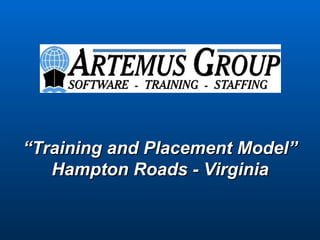Training And Staffing Examples Hampton Roads Nynj Maritime
- 1. ŌĆ£Training and Placement ModelŌĆØ Hampton Roads - Virginia
- 2. ’ü« Established in Dec 2004 as a separate venture focused on the maritime industry ’ü« Partners combined have 65 years of industry experience. ’ü« Service offerings include Shipment Management Systems, Customs reporting software, data hosting, training and staffing. ’ü« Training Focus - Create a workforce through training and placement service that can support growth in port industry of Hampton Roads while controlling costs of doing business. ’ü« Average 20-25 new people into the industry each year for the last three years
- 3. The Need ŌĆō Hampton Roads ’ü« 185,000 Port or Port Related Jobs in place today in the state. ’ü« Growth projected +5% over the next 5 years ’ü« 65,000 Port related jobs in Hampton Roads ’ü« 4 Major Terminals located in Hampton Roads
- 4. The Development of Training Class ’ü« Group of Senior Executives consisting of Carriers, Shipping Agents, Maritime Association ’ü« Competing companies with control of over 400 shipping related positions ’ü« Common Bond ŌĆ£We Need Staff who can understand the businessŌĆØ ’ü« Keep the cost of doing business controllable ŌĆō quit stealing from each other
- 5. Standard Shipping Process Rate Quotation & Tariff Intermodal Booking Transportation Cargo Vessel Arrival/Import Equipment Documentation Management & Control Terminal and Intermodal Marine Operations/ Transportation Vessel Stow and Load Export Documentation
- 6. Basic Shipping 101 ’ü« 5 Day ŌĆō 32 hour ŌĆō 3.2 CEU course ’ü« Each Day, overview, exercises and one half day field trip to the port ’ü« Last day, 2 hour final exam ’ü« CEUŌĆÖs awarded by Old Dominion University ’ü« All students receive text book, geography workbook and folder of exercises, handouts etc. ’ü« All graduates are supported by Artemus for follow up or support in their current or new positions. ’ü« Job Placement services and Tuition assistance available through GovŌĆÖt programs and local work force development
- 7. Shipping Overview and Geography ’ü« History of Shipping - from ocean shipping's start up in the Mediterranean Region through the modernization of ocean shipping today ’ü« The Shipping cycle ’ü« Geography Section - titled ŌĆ£Where in the World?ŌĆØ ’ü« Glossary of Key Shipping Terms and Acronyms
- 8. Standard Ocean Shipping Process Rate Quotation & Tariff
- 9. Rate Quotation and Tariffs ’ü« How to Quote a Rate - Key Information ’ü« Federal Maritime Commission and Conferences ’ü« The Pricing Process ŌĆó Market Analysis: CompetitorsŌĆÖ Rates ŌĆó Value Comparison: Commodity / Customer Analysis ŌĆó Profit Margin: Unit Container Contribution ’ü« How key information is used within the process of developing rates and moving cargo
- 10. Standard Ocean Shipping Process Booking Cargo
- 11. Booking Cargo ’ü« What type of service do shippers require at the time of booking? ’ü« Basic Customer Service process in the industry ’ü« Information required when taking a booking and why? ’ü« Schedules - Departure information and critical information for Shipper at the time of booking ’ü« Next Steps
- 12. Standard Ocean Shipping Process Equipment Management & Control
- 13. Equipment Management & Control Equipment ’ü« Different Types of Equipment ’ü« Equipment pools ’ü« TIRŌĆÖs - Interchange Agreements ’ü« Chassis ’ü« Street Turns ’ü« Domestic Repositioning ’ü« Empty Repositioning ’ü« Maintenance and Repair ’ü« Third Party Billing
- 14. Standard Ocean Shipping Process Intermodal Transportation
- 15. Intermodal Transportation ’ü« Railroads and Rail Yard, Trucking and Depots ’ü« Modes, Rates and Routes - making the best routing choice ’ü« Chassis Provision ’ü« Inland and Marine Terminal Facilities ’ü« Equipment Interchange ’ü« Landbridge and Mini landbridge ’ü« Leg Sheets ’ü« Alternate Port Service
- 16. Standard Ocean Shipping Process Export Documentation
- 17. Export Documentation ’ü« Outbound Documentation process ’ü« What is a Bill of Lading? ’ü« Types of Documentation required for Export ’ü« The role of the Freight Forwarder ’ü« Terms and Definitions ’ü« Customs Filing ’ü« Licenses ’ü« Legal Letters
- 18. Terminal and Marine Operations/ Vessel Stow and Load
- 19. Terminal/Marine Operations ’ü« Job Functions at Terminals ’ü« Container Yards ’ü« Vessel Types ’ü« Stevedores ’ü« Bay Plans ’ü« Loading and Discharging ’ü« Stowing a Vessel ’ü« Container Weights ’ü« Safety and Hazardous ’ü« Terminal Equipment ’ü« Port Tour (Field Trip)
- 20. Standard Ocean Shipping Process Vessel Arrival/Import Documentation
- 21. Vessel Arrival and Import Documentation ’ü« Import Documentation Process ’ü« Terms of Sale ’ü« Initiating the importation of a shipment ’ü« Customs Requirements and declarations ’ü« Types and Timing of documentation for import ’ü« Vessel arrival requirements ’ü« Vessel discharge and availability ’ü« Notifications and payment of charges
- 22. Standard Ocean Shipping Process Intermodal Transportation
- 23. Import Cargo and Container Delivery ’ü« Import Logistics and Intermodal ’ü« Mode, rates, routes ’ü« Dispatching - Communication ’ü« Empty Returns ’ü« Customer Notification and communication ’ü« Per Diems - Free Time
- 24. Shipping 101 - Exercises Create a quotation Choose proper Create a booking rates, routes and modes Vessel discharge Choose proper and preparation of equipment arrival documentation Port tour and Choose proper vessel stow as a rates, routes and class modes Create a bill of lading
- 25. Shipping 101 - Deliverable ’ü« Basic process knowledge ’ü« Big picture - effect of parts on the whole ’ü« Testing of knowledge and progression - Pre and Post test ’ü« Hard copy documents ’ü« Improve knowledge of current employees ’ü« Provide trained staff for permanent placement services
- 26. The Outcome-Successes ’ü« From 2005 ŌĆō 2007YTD ŌĆō 45 new entrants into the shipping industry ’ü« From 2005 ŌĆō 2007YTD ŌĆō 177 people completed and passed the basics of the industry ’ü« Two Maritime organizations and 40 local Hampton Roads companies supporting the program ŌĆō sending students and hiring new people ’ü« From 2004 ŌĆō 2007 ŌĆō class sizes have grown from 2 to 10 a month.
- 27. Servicing the Shipping Industry...



























